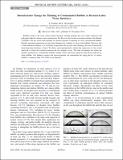| dc.contributor.author | Poulain, Stephane | |
| dc.contributor.author | Bourouiba, Lydia | |
| dc.date.accessioned | 2018-11-19T17:29:55Z | |
| dc.date.available | 2018-11-19T17:29:55Z | |
| dc.date.issued | 2018-11 | |
| dc.date.submitted | 2018-05 | |
| dc.identifier.issn | 0031-9007 | |
| dc.identifier.issn | 1079-7114 | |
| dc.identifier.uri | http://hdl.handle.net/1721.1/119193 | |
| dc.description.abstract | Bubbles reside at the water surface before bursting, emitting droplets that can contain chemicals and pathogens linked to disease and contamination. We discover that bacterial secretions enhance the lifetime of bubbles. We also reveal and elucidate two distinct regimes of thinning for such contaminated bubbles. Initially, marginal regeneration governs their thinning rate, similarly to clean water bubbles. However, due to their enhanced lifetime, it is eventually evaporation that governs their thinning, thus also dramatically decreasing their thickness at burst. We derive and experimentally validate the expression for the critical timescale at which the transition between the two regimes occurs. The shift in thinning law makes the droplets produced by contaminated bubbles smaller, faster, and more numerous than those produced by clean bubbles. Our findings suggest that microorganisms can manipulate the aging physics of surface bubbles to enhance their own water-to-air dispersal. | en_US |
| dc.description.sponsorship | United States. Department of Agriculture (Award MDW-2016-04938) | en_US |
| dc.publisher | American Physical Society | en_US |
| dc.relation.isversionof | http://dx.doi.org/10.1103/PhysRevLett.121.204502 | en_US |
| dc.rights | Article is made available in accordance with the publisher's policy and may be subject to US copyright law. Please refer to the publisher's site for terms of use. | en_US |
| dc.source | American Physical Society | en_US |
| dc.title | Biosurfactants Change the Thinning of Contaminated Bubbles at Bacteria-Laden Water Interfaces | en_US |
| dc.type | Article | en_US |
| dc.identifier.citation | Poulain, S. and Bourouiba, L. "Biosurfactants Change the Thinning of Contaminated Bubbles at Bacteria-Laden Water Interfaces." Physical Review Letters 121, 20 (November 2018): 204502 © 2018 American Physical Society | en_US |
| dc.contributor.department | Massachusetts Institute of Technology. Department of Civil and Environmental Engineering | en_US |
| dc.contributor.department | Massachusetts Institute of Technology. Department of Mechanical Engineering | en_US |
| dc.contributor.department | Massachusetts Institute of Technology. Fluid Dynamics of Disease Transmission Laboratory | en_US |
| dc.contributor.mitauthor | Poulain, Stephane | |
| dc.contributor.mitauthor | Bourouiba, Lydia | |
| dc.relation.journal | Physical Review Letters | en_US |
| dc.eprint.version | Final published version | en_US |
| dc.type.uri | http://purl.org/eprint/type/JournalArticle | en_US |
| eprint.status | http://purl.org/eprint/status/PeerReviewed | en_US |
| dc.date.updated | 2018-11-15T18:00:22Z | |
| dc.language.rfc3066 | en | |
| dc.rights.holder | American Physical Society | |
| dspace.orderedauthors | Poulain, S.; Bourouiba, L. | en_US |
| dspace.embargo.terms | N | en_US |
| dc.identifier.orcid | https://orcid.org/0000-0001-8946-4968 | |
| dc.identifier.orcid | https://orcid.org/0000-0001-6025-457X | |
| mit.license | PUBLISHER_POLICY | en_US |
